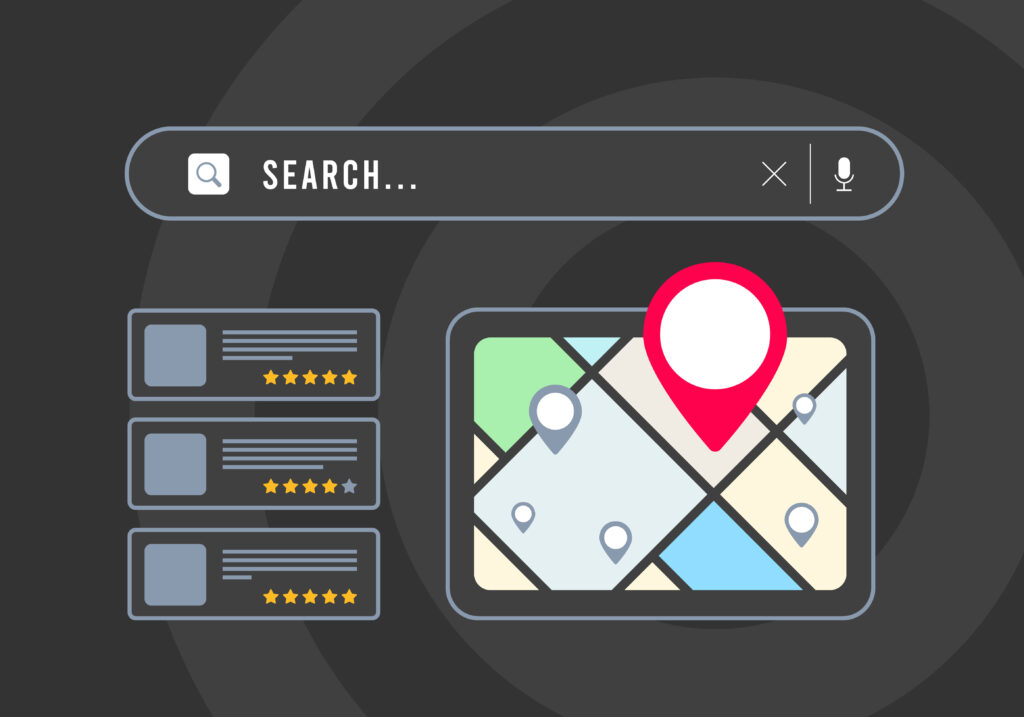Do you have a specific strategy to reach local customers? According to data by ReviewTrackers, 58% of companies don’t. A third of companies wish they had a plan in place to target local search customers, but only 30% actually do.
Local search is a compelling and affordable way to reach your target audiences. You can build entire campaigns across multiple channels that specifically reach local customers. Search engines and social media sites have also taken steps to provide more local results to people who search on them, which means the actions you take today to make a regional impact could pay off even more in the future.
It’s time to get local. Here are a few actionable ways to target local audiences across your marketing efforts.

Target “Near Me” Terms and Other Local Keywords
When optimizing for local search, the first step is to evaluate your SEO efforts. Between 2015 and 2017, searches with the term “near me” grew 150% within Google. Customers realized they could search “oil change near me” instead of specifying “oil change in Nashville” or wherever they were located. However, Google also shared some relevant statistics related to the auto industry. The biggest thing to know is that 40% of auto service shoppers need reactive services rather than routine maintenance. These are customers who need repairs immediately and are looking for the closest option.
Evaluate your search efforts to make sure you are optimizing for local terms. These can include “near me” keywords along with hyperlocal keywords. You can optimize for your city but also for specific neighborhoods that tell customers exactly where your business is located.
Local searches are powerful because customers want to act on them. They specifically want to find the closest location before visiting it. According to the ReviewTrackers survey mentioned earlier, 40% of millennials say the majority of their local searches result in them actually visiting the business. In comparison, 30% say about half of their searches result in them going to a business. This is still an impressive amount. By making your brand searchable locally and creating a good first online impression, you can actively drive customers to your locations.
Optimize Your Paid Ads With Local Terms and Geotargeting
The next step after you develop a local SEO plan is to look at your paid search ads. When it comes to PPC, brands need to look for “low-hanging fruit,” which refers to low-cost keywords that drive high levels of traffic. Local keywords allow you to reduce your costs by competing on a regional scale while still targeting high-demand terms.
For example, the average cost per click in the auto repair industry is $2.46. However, some terms are highly competitive, which drives up their price. The average CPC for “change oil light” is $35 per click, while the “aftermarket automotive warranty” costs $25 per click. If you can build local terms around high-demand keywords, you can lower the CPC while still ranking highly for those words and phrases.
Keep in mind that some regions have higher CPCs than others. If you get into a PPC bidding war with your competitors, you could drive up your costs without gaining much more traffic. However, targeting local words and using “near me” in your campaigns can help you run a more optimized campaign.
Make sure you also use geofencing to target specific regions that you want to advertise in. While Google is usually good at showing local ads to local users, you don’t want to accidentally compete for clicks on a national level when you only want to reach nearby customers.
Don’t Neglect Your Business Profile
One of the most powerful tools you can harness if you want to invest in local marketing is your Google Business Profile. This block of information shows up when someone searches for your business or a related term (e.g., nearby Dodge dealer). Too often, brands treat this box as a “set it and forget it” optimization task. However, it needs to be something you maintain regularly if you want to get the most from it. Here are a few tasks to keep up with.
- Respond to customer reviews, even if you are just thanking someone for visiting your showroom.
- Answer questions in a timely manner. You can also post your own questions and answer them to add more information.
- Check your business hours whenever you change them. Update the hours for the holiday season.
- Review your photos to make sure they are useful and professional.
- Post updates about deals, events, new models, and customer opportunities.
Your audience can access this information on standard Google searches and through Google Maps when they are looking for relevant services. The more information you provide, the more questions you can answer for potential customers.
Think About Voice Search Users
Nearly 395 million homes have smart products in use, from smart thermostats to voice assistants. This has created an entire digital marketing tactic for driving local traffic to your business. Consider how your local efforts can work with smart speakers to increase your brand exposure through these tools.
When targeting voice search results, it’s okay to optimize for question keywords and long-tail phrases. This is because people are more conversational when they talk to their digital assistants. They are more likely to ask, “Where is the nearest place to get an oil change?” than to bar, “oil change near me,” as they would type it.
Once you have your keywords in place, look at your content efforts. Voice search content is often more conversational because that is how the digital assistant speaks. If you have conversational content in your writing — which means you are already connecting with readers in an engaging way — then you might pick up more traffic through smart speakers.
It’s worth your resources to target voice assistants because they are another highly actionable medium. Someone who wants to make a service appointment or find a dealership in their area is looking to convert. You can drive people to your showroom and call center through this channel and track its effectiveness over time.
Incorporate Local Elements In Your Video Content
Once you update your technical digital efforts to incorporate local elements, turn to your creative division. You can include local topics, scenes, and landmarks in your video and image-based content to appeal to viewers. Tap into local pride and make people excited to see their neighborhoods and businesses in your videos.
For example, if you want to show off the latest model that just rolled in, take it for a test drive through some of the most iconic streets in your area. Bring someone along to hold the camera to show off how beautiful your town is and how great the car looks cruising through it. If you want to highlight local businesses, create a “What’s for Lunch?” series where you drive to a different local eatery in various vehicles and talk to the owners and staff.
Incorporating local footage in your video content is easy if you already plan to shoot your content in natural light. There are countless places in your area that can match your ideal branding and content goals. You can take a small SUV to a nearby park with a beautiful waterfall in the background or drive a sedan to a local sports venue when your team makes the playoffs.
Track the engagement rates and viewership levels of these local videos and see how they differ from content in staged areas or live updates made at your dealership.

Create a Local Experience
Customers increasingly want to work with local brands and buy from their neighbors. In a survey by Score, only one percent of shoppers say they plan to patronize businesses less often, while 48% plan to visit more local businesses in the future. When asked why they prefer local businesses, consumers say they offer more personalized service (96%), are more trustworthy (91%), and provide better customer service (80%).
You can work with your digital marketing team to optimize for local search terms and develop unique local campaigns, but your business also needs to create a local experience. Connecting with customers and providing quality care is an essential part of running any dealership and makes your business part of the community.
Presenting a car dealership as a local business can be challenging because you sell national brands. While your dealership is locally owned, many people still associate it with the brands you carry (Toyota, Ford, Hyundai, etc.). This is also a challenge for your service department, which has to compete with local car repair shops in the area.
Take steps to immerse your brand in the community. Attend local events, sponsor little-league teams, and treat your customers like your neighbors. All of these steps support your marketing efforts and can improve your after-sale efforts with customers.
Take a Local Approach With J&L Marketing
Local marketing isn’t a specific tactic. Instead, it is an overarching strategy that you can implement across a variety of digital channels. From your paid search ads to display content, you can build local connections and reach nearby audiences. If you are like 58% of businesses that don’t have a local marketing strategy, you are missing out. Our team is here to help.
Reach out to the experts at J&L Marketing for help developing local solutions for your car dealership. We can look at your opportunities and barriers to success to create a plan that overcomes them. Through our efforts, we can grow your traffic and customer base without exceeding your budget. Call us today, and we will do our best to make your business a local household name.



